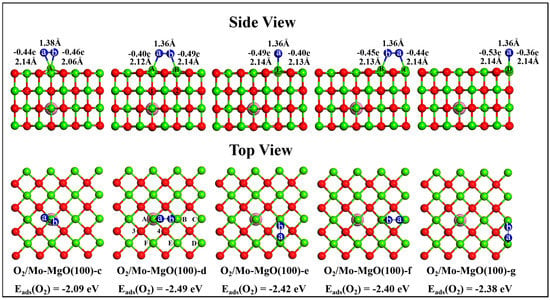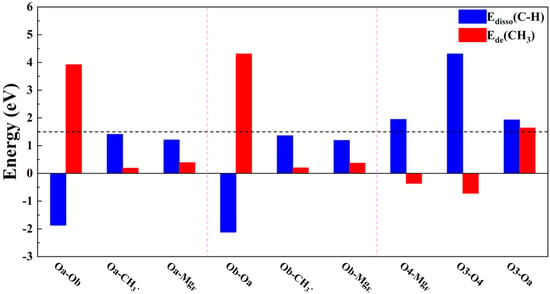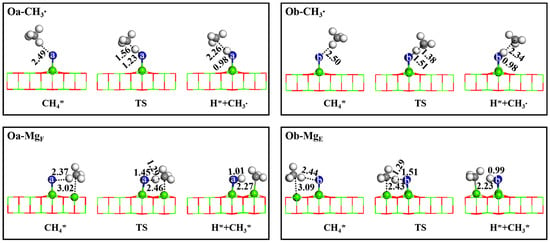Abstract
In this work, density functional theory calculations are performed to explore the unique role of Mo dopant on MgO in oxidative coupling of methane. It is revealed that subsurface Mo dopant significantly enhanced the adsorption and activation of oxygen molecules. The combination of adsorbed oxygen and surface Mg exhibited a balanced activity for C-H bond activation and release of methyl radical which paves the way to activate methane with a promising yield.
1. Introduction
As the main component of natural gas and shale gas, methane is an important feedstock for chemical production [1,2,3]. However, methane possesses an extremely strong C-H bond with a strength of 435 kJ/mol which often requires elevated temperature for activation. Hence, efficient methane activation is deemed as the “golden grail” in heterogeneous catalysis [4,5,6]. Currently, the transformation of methane to value-added chemicals such as methanol, formic acid, and aromatics mainly proceeds via the indirect route which involves a conversion to syngas (CO + H2) as the intermediate step. The indirect route is an energy extensive process with not-so-high conversion and selectivity. The direct conversion of methane is often more desirable. In fact, there have been reported several catalytic processes which include partial oxidation of methane, dry/stream reforming of methane, and oxidative coupling of methane, etc. [3].
Among them, oxidative coupling of methane (OCM) is a dream reaction which converts methane to C2 products such as ethane and ethylene [7]. Similar to the other routes, OCM also takes place at a high temperature above 500 °C. The high temperature promotes the deep oxidation of methane which subsequently significantly reduces the selectivity. Due to this bottleneck, the industrial implementation of OCM is still unreachable [8,9]. Hundreds of catalysts have been examined for OCM. Lithium-doped magnesium oxide (Li/MgO) perhaps is the most studied OCM catalyst ever [7,10] Initially, Lunsford group found that Li-doped MgO has impressive catalytic performance in OCM [11]. Moreover, they proposed [Li+O−] is the active center during reaction which is supported from EPR characterization [12]. Since then, there have been continuous efforts to identify an active center and reaction mechanism. Recent studies cast doubt on the role of Li dopant which might be a structural modifier instead. For example, Schlögl et al., proposed that Li doping changed the number of exposed under-coordinated O2− at steps or corners [13,14]. Hargreaves and Zavyalova found that high-index crystalline planes of MgO such as (111) and (110) have a better performance in OCM than (100) [15]. On the other hand, there are generally two routes for methane dissociation which lead to formation of either methyl radicals in the gas phase or adsorbed methyl on the surface. It is ideal to release methyl radicals from the surface which can subsequently undergo a series gas phase reaction to generate ethane and ethylene. However, the adjustment of methane dissociation in a controlled way is a tricky issue which is related to coordination, spin and the acid/base of the active site. Although there are various means to tune OCM performance, doping is still considered as an indispensable factor for the performance of the alkali metal oxide catalyst.
Besides lithium, other alkali metals such as Na and K are also often observed dopants for MgO. Molybdenum is another commonly used dopant for metal oxide although it might not be the usual one for OCM. Reports from Nilius’s group found that Mo-doped MgO has remarkable catalytic capabilities for oxygen activation at room temperature [16]. Interestingly, they identified that Mo is more stable at the subsurface rather than the topmost layer of oxide from a combined DFT and experimental verification. This work has an important implication on OCM due to its strong ability to activate oxygen molecules at low temperature which potentially decreases the side reactions. On the other hand, dopants with different valence demonstrated distinct activities towards C-H bond activation. Whereas, it is worth investigating the catalytic performance of Mo-doped MgO in OCM. In this work, DFT calculations are performed to reveal the effects of Mo doping for
MgO catalyst in OCM. The pronounced effects of Mo on oxygen adsorption and activation are confirmed and analyzed in detail. The resulting active oxygen species directly participate in methane activation. The complete pathway of methyl radical formation is presented. The current study provides not only solid evidence for the active role of Mo dopant but also deepens the understandings of OCM.
2. Results and Discussion
It is often proposed that the Mars–van Krevelen mechanism is applied for the doped MgO catalyst in OCM, which assumes a methane-reduced catalyst. Afterwards, oxygen restores the active site. This seems not to apply to Mo-doped MgO. The adsorption of the oxygen molecule is much stronger than for methane. As shown in Figure 1, the oxygen molecule has an adsorption energy over −2 eV on Mo-doped MgO while methane adsorption is below −0.3 eV, as indicated from the calculations. More interestingly, the adsorption sites for the oxygen molecule are quite delocalized. All magnesium atoms at the topmost layer have abilities to bind the oxygen molecule. The adsorption energy is around −2.4 eV except for both oxygen atoms binding at single Mg which has an adsorption energy of −2.09 eV. Not only binding energy but also the bond length of adsorbed oxygen shows a similar trend. All adsorbed oxygen molecules are stretched from 1.21 A to 1.36 A which is an indication of O2− formation. This is further verified from the charge analysis as nearly 1 e is transferred to the oxygen molecule after adsorption. The bond distance between the oxygen and surface Mg site is almost identical, being around 2.13 A, and is nearly the sum of the covalent radius of oxygen and magnesium. Therefore, it is ascertained that a strong covalent bonding is formed between the adsorbed oxygen molecule and surface Mg. It is also noted that the adsorption of the oxygen molecule is significantly enhanced by Mo doping compared with the undoped MgO. The adsorption energy of the latter case is below −0.15 eV as shown in Figure S1. The weak adsorption of methane on undoped MgO is further evidenced from the bond length which is slightly increased to be 1.24 with negligible charge transfer. Overall, Mo doping is indeed beneficial to oxygen molecule adsorption and activation on MgO.

Figure 1.
The optimized structure of oxygen molecule on Mo-doped MgO(100). The charge, bond distance, and adsorption energy are also included. Mg atom is in green and oxygen is in red while gas phase oxygen molecule is in blue.
The first C-H bond activation in methane molecule and the release of methyl radical is the key to the catalytic performance of OCM. The activation of methane and methyl radical formation are carefully investigated for the adsorbed oxygen molecule on MgO as shown in Figure 1 (O2/Mo-MgO(100)-d) which possessed the largest binding energy. The methane dissociation has two fragments which are hydrogen and methyl group, respectively. These two fragments bind at two sites on the surface. The binding sites, including the adsorbed oxygen molecule, surface oxygen and magnesium, are investigated at the same footing as shown in Figure 2. Due to the weak methane adsorption, it is suggested that oxygen molecule adsorption will be the first step to initiate OCM on Mo-doped MgO. Two descriptors which are methane dissociation energy (Edisso) and methyl desorption energy (Ede) are used to distinguish the reactivity of different sites. As shown in Figure 2, the adsorbed oxygen molecule (Oa and Ob) indeed demonstrates the best performance regarding methane dissociation with highly exothermic dissociation energy over 2 eV. Conversely, the methane dissociations at the other surface sites (O and Mg) are all endothermic. Owing to its better reactivity, the binding of methyl is also significantly stronger than other sites which caused a big desorption of energy. Therefore, a balanced performance for methane dissociation and methyl desorption is required to reach optimal performance. According to this principle, the combination of adsorbed oxygen (Oa, Ob) and surface Mg yields the best performance. Moreover, there are two different pathways under investigation at these favorable sites including (Oa-CH3, Ob-CH3, Oa-MgF, and Ob-MgE) as shown in Figure 3. The first pathway is that the adsorbed oxygen molecule (Oa, Ob) attacks the methane molecule and abstracts one of the hydrogen atoms which directly forms methyl radical. The barrier associated with hydrogen abstraction is calculated to be 1.36 and 1.03 eV at Oa and Ob sites, respectively, as shown in Figure 3.

Figure 2.
The dissociation energy (Edisso) and desorption energy (Ede) of methane at various sites on Mo-doped MgO(100). The labels associated with binding sites are indicated in Figure 1 dopant effects in OCM but also provide insight into the future design of the doped metal oxide catalyst.


Figure 3.
The reaction pathway and configurations along pathway of methane activation on Mo- doped MgO(100).
The second pathway is that methane activation occurred between adsorbed oxygen and surface magnesium sites. The dissociation fragments, CH3 and H, bind at oxygen (Oa or Ob) and surface Mg, respectively. It is noted that the barrier of hydrogen abstraction is lower than the first pathway which is 0.76 and 0.85 eV at Oa-MgF and Ob-MgE, respectively. However, the release of methyl radical on the second pathway is more energy-demanding than the first pathway. Overall, the calculations indicate the active role of the adsorbed oxygen molecules in methane activation. They not only acted as active sites to break the C-H bond but also triggered the reactivity of surface atoms. Moreover, the first C-H bond activation has the largest barrier of all investigated pathways which is deemed as a rate-limiting step.
Considering the importance of adsorbed oxygen molecules, the other configurations of oxygen molecules on MgO are also investigated for methane activation as shown in Figure S2. Methane activation proceeded in a similar way for all sites. It starts with a weak physisorption of methane with adsorption energy below −0.3 eV. The adsorbed methane molecule resides between the adsorbed oxygen molecule and surface Mg with nearly equal distance. One of the hydrogen atoms from the methane molecule approached Oa/Ob sites at transition state (TS) which caused the C-H bond to break. The calculated barrier of C-H is 0.85, 0.98, 1.22, and 1.28 eV for configurations d–f shown in Figure 1. The co-adsorption of CH3 and H is an endothermic process for all cases after the first hydrogen abstraction. The energy span between methane adsorption and co-adsorption of CH3 and H is indicated in Figure S2. The comparison reveals the Ob-MgA combination in configuration e, as shown in Figure 1, has the best reactivity with the smallest energy cost. It is interesting to observe that the desorption energy of the CH3 radical does not exceed over 0.5 eV. This is much smaller than the C-H bond activation barrier. Therefore, the generation of methyl radical will be easy under the condition of C-H bond activation. It is concluded that the adsorbed oxygen molecule is indeed beneficial for methyl radical formation.
3. Conclusions
In this work, DFT calculations were performed to explore the reaction pathway and mechanism of Mo-doped MgO in methane oxidative coupling. It was found that the adsorption of the oxygen molecule significantly increased with the presence of Mo dopant. Moreover, the adsorbed oxygen molecule demonstrated excellent reactivity for methane activation. It is indicated that the adsorbed oxygen molecule not only behaves as an active site by itself but also successfully adjusts the catalytic properties of surface magnesium atoms. The calculations indicated that dual site adsorption of CH3 and H is more favorable than the direct release of methyl radical. Moreover, the rate-limiting step was identified as the first hydrogen abstraction. The release of methyl radical from the surface is much facilitated with the cooperation between the adsorbed oxygen and surface magnesium. Overall, the current work identifies the importance of Mo doping and gives unique insight into further improvements for OCM catalysts.
Supplementary Materials
The following supporting information can be downloaded at: www.mdpi.com/article/10.3390/catal12101083/s1, Figure S1: The adsorption energy and configuration of oxygen molecule on undoped MgO(100); Figure S2: Reaction pathways of methane activation on Mo doped MgO(100) with adsorbed oxygen molecule and the configurations of key species [17,18,19,20,21,22,23].
Funding
This work is supported by the National Natural Science Foundation of China (22172100, 92145301, 91845201) and Liaoning Natural Science Foundation (2019-ZD-0908). The support from the Engineering Technology Research Center of Catalysis for Energy and Environment, Major Platform for Science and Technology of the Universities in Liaoning Province, Liaoning Province Key Laboratory for Highly Efficient Conversion and Clean Utilization of Oil and Gas Resources, and Engineering Research Center for Highly Efficient Conversion and Clean Use of Oil and Gas Resources of Liaoning Province are highly appreciated.
Conflicts of Interest
The authors declare no conflict of interest.
References
- Taifan, W.; Baltrusaitis, J. CH4 Conversion to Value Added Products: Potential, Limitations and Extensions of a Single Step Heterogeneous Catalysis. Appl. Catal. B Environ. 2016, 198, 525–547. [Google Scholar] [CrossRef]
- Meng, X.; Cui, X.; Rajan, N.P.; Yu, L.; Deng, D.; Bao, X. Direct Methane Conversion under Mild Condition by Thermo-, Electro-, or Photocatalysis. Chem 2019, 5, 2296–2325. [Google Scholar] [CrossRef]
- Schwach, P.; Pan, X.; Bao, X. Direct Conversion of Methane to Value-Added Chemicals over Heterogeneous Catalysts: Challenges and Prospects. Chem. Rev. 2017, 117, 8497–8520. [Google Scholar] [CrossRef] [PubMed]
- Rogge, T.; Kaplaneris, N.; Chatani, N.; Kim, J.; Chang, S.; Punji, B.; Schafer, L.L.; Musaev, D.G.; Wencel-Delord, J.; Roberts, C.A.; et al. C–H Activation. Nat. Rev. Methods Primers 2021, 1, 43. [Google Scholar] [CrossRef]
- Dalton, T.; Faber, T.; Glorius, F. C–H Activation: Toward Sustainability and Applications. ACS Cent. Sci. 2021, 7, 245–261. [Google Scholar] [CrossRef]
- Panda, B. Joy and Challenges of Alkynylation of Arenes and Heteroarenes through Double C−H Functionalizations. Asian J. Org. Chem. 2020, 9, 492–507. [Google Scholar] [CrossRef]
- Hutchings, G.J.; Scurrell, M.S.; Woodhouse, J.R. Oxidative Coupling of Methane Using Oxide Catalysts. Chem. Soc. Rev. 1989, 18, 251–283. [Google Scholar] [CrossRef]
- Gambo, Y.; Jalil, A.A.; Triwahyono, S.; Abdulrasheed, A.A. Recent Advances and Future Prospect in Catalysts for Oxidative Coupling of Methane to Ethylene: A Review. J. Ind. Eng. Chem. 2018, 59, 218–229. [Google Scholar] [CrossRef]
- Postma, R.S.; Keijsper, D.J.; Morsink, B.F.; Siegers, E.H.; Mercimek, M.E.E.; Nieukoop, L.K.; van den Berg, H.; van der Ham, A.G.J.; Lefferts, L. Technoeconomic Evaluation of the Industrial Implementation of Catalytic Direct Nonoxidative Methane Coupling. Ind. Eng. Chem. Res. 2021, 61, 566–579. [Google Scholar] [CrossRef]
- Lunsford, J.H. The Catalytic Oxidative Coupling of Methane. Angew. Chem. Int. Ed. 1995, 34, 970–980. [Google Scholar] [CrossRef]
- Lin, C.H.; Ito, T.; Wang, J.; Lunsford, J.H. Oxidative Dimerization of Methane over Magnesium and Calcium Oxide Catalysts Promoted with Group IA Ions: The Role of [M+O−] Centers. J. Am. Chem. Soc. 1987, 109, 4808–4810. [Google Scholar] [CrossRef]
- Campbell, K.D.; Lunsford, J.H. Contribution of Gas-Phase Radical Coupling in the Catalytic Oxidation of Methane. J. Phys. Chem. 1988, 92, 5792–5796. [Google Scholar] [CrossRef]
- Kwapien, K.; Paier, J.; Sauer, J.; Geske, M.; Zavyalova, U.; Horn, R.; Schwach, P.; Trunschke, A.; Schlögl, R. Sites for Methane Activation on Lithium-Doped Magnesium Oxide Surfaces. Angew. Chem. Int. Ed. 2014, 53, 8774–8778. [Google Scholar] [CrossRef]
- Schwach, P.; Hamilton, N.; Eichelbaum, M.; Thum, L.; Lunkenbein, T.; Schlögl, R.; Trunschke, A. Structure Sensitivity of the Oxidative Activation of Methane over MgO Model Catalysts: II. Nature of Active Sites and Reaction Mechanism. J. Catal. 2015, 329, 574–587. [Google Scholar] [CrossRef]
- Zavyalova, U.; Weinberg, G.; Frandsen, W.; Girgsdies, F.; Risse, T.; Dinse, K.P.; Schloegl, R.; Horn, R. Lithium as a Modifier for Morphology and Defect Structure of Porous Magnesium Oxide Materials Prepared by Gel Combustion Synthesis. ChemCatChem 2011, 3, 1779–1788. [Google Scholar] [CrossRef]
- Cui, Y.; Shao, X.; Baldofski, M.; Sauer, J.; Nilius, N.; Freund, H.-J.J. Adsorption, Activation, and Dissociation of Oxygen on Doped Oxides. Angew. Chem. Int. Ed. 2013, 52, 11385–11387. [Google Scholar] [CrossRef]
- Kresse, G.; Hafner, J. Ab Initio Molecular Dynamics for Liquid Metals. Phys. Rev. B 1993, 47, 558–561. [Google Scholar] [CrossRef]
- Kresse, G.; Furthmüller, J. Efficient Iterative Schemes for Ab Initio Total-Energy Calculations Using a Plane-Wave Basis Set. Phys. Rev. B 1996, 54, 11169. [Google Scholar] [CrossRef]
- Kresse, G.; Furthmüller, J. Efficiency of Ab-Initio Total Energy Calculations for Metals and Semiconductors Using a Plane-Wave Basis Set. Comput. Mater. Sci. 1996, 6, 15–50. [Google Scholar] [CrossRef]
- Blöchl, P.E. Projector Augmented-Wave Method. Phys. Rev. B 1994, 50, 17953–17979. [Google Scholar] [CrossRef]
- Hammer, B.; Hansen, L.B.; Nørskov, J.K. Improved Adsorption Energetics within Density-Functional Theory Using Revised Perdew-Burke-Ernzerhof Functionals. Phys. Rev. B 1999, 59, 7413–7421. [Google Scholar] [CrossRef]
- Grimme, S.; Ehrlich, S.; Goerigk, L. Effect of the Damping Function in Dispersion Corrected Density Functional Theory. J. Comput. Chem. 2011, 32, 1456–1465. [Google Scholar] [CrossRef] [PubMed]
- Henkelman, G.; Uberuaga, B.P.; Jonsson, H. A Climbing Image Nudged Elastic Band Method for Finding Saddle Points and Minimum Energy Paths. J. Chem. Phys. 2000, 113, 9901–9904. [Google Scholar] [CrossRef]
Publisher’s Note: MDPI stays neutral with regard to jurisdictional claims in published maps and institutional affiliations. |
© 2022 by the authors. Licensee MDPI, Basel, Switzerland. This article is an open access article distributed under the terms and conditions of the Creative Commons Attribution (CC BY) license (https://creativecommons.org/licenses/by/4.0/).